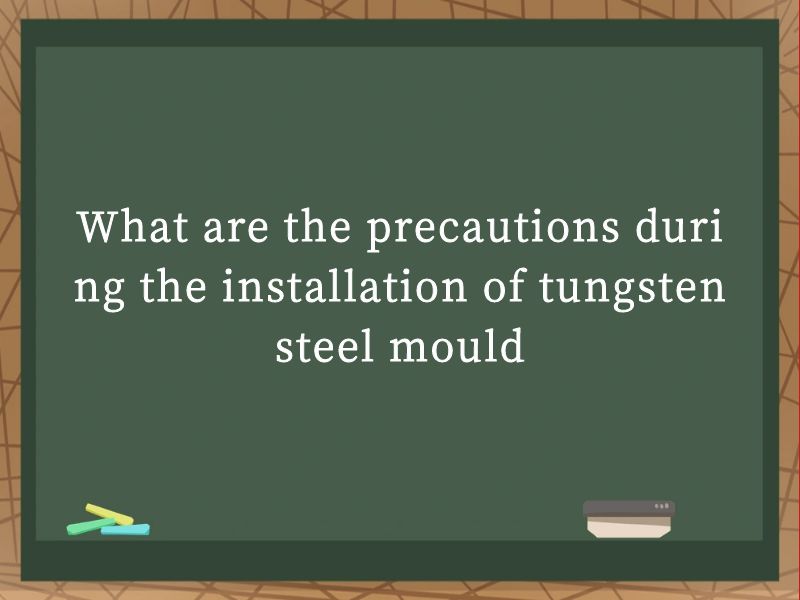JOURNALISM
- NEWS -
|
|
What are the precautions during the installation of tungsten steel mouldWhat are the precautions during the installation of tungsten steel mould?The installation of tungsten steel moulds is a crucial step in the manufacturing process, particularly in industries such as automotive, aerospace, and precision tooling. Tungsten steel, known for its hardness, wear resistance, and high-temperature stability, makes it an ideal material for creating moulds that can withstand the rigorous demands of molding and casting processes. However, installing such moulds requires meticulous attention to detail to ensure optimal performance and longevity. This article delves into the key precautions that one should undertake during the installation of tungsten steel moulds, highlighting techniques and practices that can significantly enhance the overall quality and reliability of the finished product.
Preparation Before Installation Before embarking on the installation process, thorough preparation is paramount. Ensuring that all necessary tools, equipment, and safety gear are readily available is the first step. This includes, but is not limited to, precision measurement tools, torque wrenches, lifting equipment, and personal protective equipment (PPE) such as gloves, safety glasses, and hearing protection. 1. Inspection of Mould Components A meticulous inspection of each mould component should be conducted to identify any defects, cracks, or wear marks. Tungsten steel, while durable, can still suffer from imperfections that could compromise its integrity during use. Any identified issues should be addressed promptly, either through repair or replacement. 2. Cleaning and Lubrication Cleaning the mould and its mating surfaces is crucial to remove any contaminants, such as grease, dust, or debris, that could interfere with the installation process or lead to premature wear. A suitable solvent or cleaner should be used, followed by a thorough rinsing and drying. Additionally, the use of appropriate lubricants can facilitate the assembly process and reduce friction between moving parts. It is essential to choose lubricants that are compatible with tungsten steel and the molding process. Precision Alignment and Fitting The precision of alignment and fitting during installation is critical for the accuracy and functionality of the mould. Even minor misalignments can lead to significant issues, including premature wear, dimensional inaccuracies, and even mould failure. 3. Use of Precision Tools Precision tools such as micrometers, calipers, and dial indicators are indispensable for ensuring that all components are correctly aligned and fitted. These tools allow for accurate measurements and adjustments, ensuring that the mould is installed to the tightest tolerances possible. 4. Torque Specifications Fasteners, such as bolts and screws, play a vital role in securing the mould components. Applying the correct torque to these fasteners is crucial. Over-tightening can lead to stress fractures or deformation, while under-tightening can result in component loosening and potential failure. Referring to the manufacturer's torque specifications is essential to avoid these pitfalls. Assembly Techniques The assembly process itself requires a blend of technical skill and careful execution. Each step should be approached with a mindful eye towards detail and precision. 5. Sequential Assembly Following a sequential assembly process ensures that each component is installed in the correct order, facilitating a smooth and efficient installation. This typically involves assembling the base plate first, followed by the core and cavity inserts, and finally, the clamping and ejector mechanisms. 6. Monitoring Clearances Maintaining appropriate clearances between moving parts is essential for smooth operation and longevity. Clearances should be checked regularly during the assembly process to ensure they meet the specified tolerances. Adjustments may be necessary to maintain the desired clearances, which can be facilitated using shims or spacers. Handling and Storage The handling and storage of tungsten steel moulds require special considerations to prevent damage and maintain their integrity. 7. Proper Lifting Techniques When lifting or moving tungsten steel moulds, proper lifting techniques and equipment should be used. This includes the use of slings, spreader bars, and other lifting accessories designed to distribute weight evenly and minimize stress on the mould components. 8. Storage Conditions Storage conditions should be controlled to prevent corrosion, deformation, and other forms of damage. This typically involves storing moulds in a cool, dry environment, away from sources of moisture, dust, and corrosive chemicals. Additionally, moulds should be stored in a way that minimizes stress on the components, such as by placing them on flat, stable surfaces. Testing and Validation Once the mould is installed, it should undergo rigorous testing and validation to ensure that it meets the required specifications and performs as expected. 9. Functional Testing Functional testing involves running the mould through a series of cycles to assess its performance under actual operating conditions. This can help identify any issues such as leaks, dimensional inaccuracies, or premature wear. Any identified issues should be addressed promptly to avoid potential downtime and cost overruns. 10. Dimensional Verification Dimensional verification involves measuring the mould components to ensure that they meet the specified tolerances. This can be done using precision measurement tools such as coordinate measuring machines (CMMs) or laser scanners. Ensuring that the mould is dimensionally accurate is crucial for producing parts that meet the required specifications. Operator Training and Competence The installation of tungsten steel moulds is a highly skilled task that requires a combination of technical knowledge and practical experience. Ensuring that operators are adequately trained and competent is essential for the successful installation and operation of the mould. 11. Training Programs Comprehensive training programs should be implemented to ensure that operators are familiar with the installation process, the tools and equipment required, and the safety precautions that need to be taken. Training should also cover troubleshooting and maintenance procedures, enabling operators to address issues promptly and efficiently. 12. Continuous Improvement Continuous improvement practices should be adopted to identify and address any inefficiencies or issues in the installation process. This can involve regular audits, feedback sessions with operators, and the implementation of new techniques and technologies. By fostering a culture of continuous improvement, organizations can enhance the quality and reliability of the installation process, leading to improved productivity and reduced costs. Documentation and Record-Keeping Maintaining accurate documentation and records is essential for tracing any issues that may arise during the installation or operation of the mould. 13. Detailed Documentation Detailed documentation should be maintained throughout the installation process, including inspection reports, measurement data, torque values, and any adjustments made. This information can be invaluable for troubleshooting and quality assurance purposes. 14. Maintenance Records Maintenance records should be kept to track the history of repairs, replacements, and inspections performed on the mould. This information can help identify patterns or trends that may indicate underlying issues or areas for improvement. Safety Considerations Safety should always be a top priority during the installation of tungsten steel moulds. Implementing robust safety measures can help protect operators from harm and minimize the risk of accidents. 15. Hazard Assessment A thorough hazard assessment should be conducted to identify potential hazards associated with the installation process. This can help determine the appropriate PPE and safety measures required to mitigate these hazards. 16. Emergency Procedures Emergency procedures should be established and communicated to all operators to ensure that they know how to respond in the event of an accident or emergency. This includes knowing how to shut down equipment, evacuate the area, and provide first aid if necessary. In conclusion, the installation of tungsten steel moulds is a complex and critical process that requires meticulous attention to detail and a blend of technical skill and practical experience. By adhering to the precautions outlined in this article, organizations can ensure the successful installation and operation of their moulds, leading to improved productivity, reduced costs, and a higher quality of finished products. By focusing on preparation, precision, operator training, documentation, and safety, organizations can mitigate the risks associated with the installation process and achieve optimal results. |


